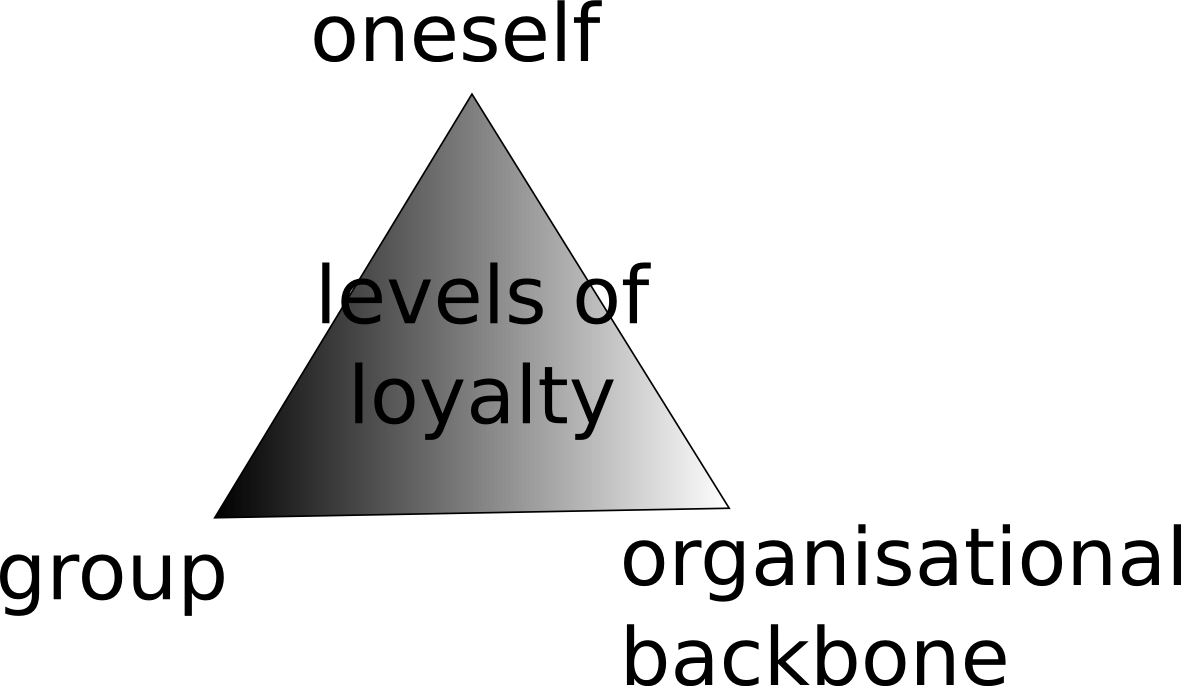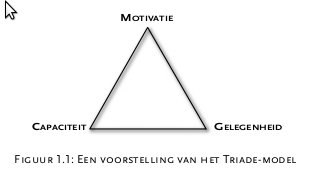In 1999 Prof. dr. Theo Poiesz published a book called ‘Gedragsmanagement’ (behavioral management), explaining the triade model. A model based on his research on Human Movement Sciences.
Poiesz uses a factorization of Motivation, Ability and Opportunity (Dutch: motivatie, capaciteit, gelegenheid) as guidance towards targetted behavior. The model offers a simple system for the explanation, influence and prediction of behavior. It is up to the user of the model, which behavior is targetted. The model suggests three necessary causes of the targetted behavior:
- Motivation: the degree of a persons interest in (the result of) this behavior
- Ability: the degree of a persons skills, capacity, experience and instruments to show this behavior
- Opportunity: the degree to which time and circumstances stimulate or obstruct this behavior
Using a factorization (T) means that when one of the factors is significantly lower than the others, it will bring down the total result: T = M * A * O.
Poiesz makes a distinction between intrinsic elements (belonging naturally, essential) and extrinsic elements (coming or operating from outside) of each factor, for example:
| intrinsic | extrinsic | ||
| motivation | interest, satisfaction |
encouragement, appreciation |
M |
| ability |
fitness, |
quality of material |
A |
| opportunity | reserved personal planning, time & place |
facities, external conditions |
O |
| TOTAL |
All factors need to be concerned at all times: i.e. when a person cannot find the time to act (unreachable O), he could decide to give up (lowering M). And by just informing (raise A) & facilitating (raise O), Motivation is not necessarrilly activated.
Note that a high intrinsic motivation can over rule a low extrinsic motivation. And vice versa.
Poiesz states subjects to score themselves. His approach is an individual one. Mine is targetted towards group behavior.
Therefore my preliminary hypothesis is: When groupmembers use the triade model to score not only themselves, but also the other group members, expressing these assumptions -with a visual reference- will help them overcome differences in complex situations.
The question is, how to visualize models like TriadeModel (like antother model in this prototype), in order to change behavior or change an attitude (opening up attitudes and lowering assumptions) AND help maintain such a change. Perhaps it’s easier to open up when using the triadmodel to ‘judge’ the behavior of each others organisation instead, avoiding intimacy barriers.
What if we could train subjects to actively use just one specific type of model? A model which allows direct feedback. Perhaps the Rose of Leary (adapted and simplified from the 1956 publication). I sometimes draw ‘the Rose’ -for myself- in a meeting, when I get the feeling I can’t connect with a person. I then helps to map his/her behavior (compliant vs blocking and superior vs inferior), because this way I can recognize my own automatic behavior and exchange this for the most optimal behavioral style.
Of course, when going even deeper into this rabibit hole, we can also assume that every behavior can be a unaware trick or a deliberate tactic (stages of competence, Motivation and personality, 1954, Maslow). Especially when taking the traid of Poiesz into account at the same time!
It seems we have a multi-dimensional problem. Let us count which dimensions we have so far:
- Intrinsic and extrinsic behavior, labelled with factors of motivation, ability and opportunity (Theo Poiesz)
- Compliant vs blocking and superior vs inferior attitude (Timothy Leary)
- Stages of competence: (un)consious and (in)competence (Abraham Maslow)
Complementary states like being deceiving or constructive & vulnerable or strong seem to frolic through these dimensions. And let us not forget differentiation over place, time and decision making unit (example).
When looking for a way to lower the energy drain in complex situations, we must conclude that multidimensional indivual behavior somehow is setting the stage for emergent group behavior. Within that group lure new -inertia driven- challenges, like flocking members or convergence towards the first solution. Nevertheless, we cannot neglect the possible origins of these new challenges: the underlying individual dimensions.
Surprisingly the tension of loyalty to both oneself, to the group and to the organizational backbone does not appear in literature about group behavior.

Loyalty sure is explored (1) by Hirschmann (‘exit or voice’) and (2) in public good games and consumer/brand behavior, although such research is mostly individually orriented and focussing on physical outcome (win/lose) instead of intertwined soft skills.
So far I did not find a direct connection in literature between the dimensions stated above (behavior, attitude, stages, states) and group behavior.
This is a field for further exploration. Perhaps by making these levels of loyalty explicit within the group, in a way that a constructive dialogue emerges, with a shared perspective of just the right dimensions needed in exactly that moment…
